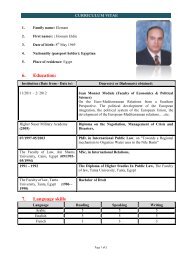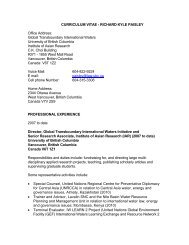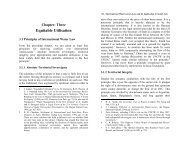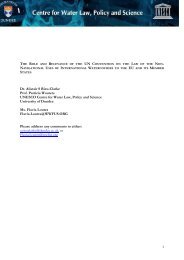Upreti, Trilochan, International Watercourses Law and Its Application ...
Upreti, Trilochan, International Watercourses Law and Its Application ...
Upreti, Trilochan, International Watercourses Law and Its Application ...
Create successful ePaper yourself
Turn your PDF publications into a flip-book with our unique Google optimized e-Paper software.
284 / <strong>International</strong> <strong>Watercourses</strong> <strong>Law</strong> <strong>and</strong> <strong>Its</strong> <strong>Application</strong> in South Asia Conclusions <strong>and</strong> Recummendations / 285precious water resources: withdrawals are expected to rise by31% by 2020 <strong>and</strong> groundwater resources are being replenishedonly at a rate of between 0.1% <strong>and</strong> 0.5%. 23 There arepredictions that the next war will be fought over water, if theinternational community does not work hard in unison bypromptly <strong>and</strong> prudently taking into account the interests of all,equally. 24 Such a gloomy picture presents either a recipe forconflict or an incentive to co-operation.However, the key to regional as well as bilateral cooperationlargely depends on how India, as a regional power willing to bea member of Security Council of the United Nations, 25reconciles its views <strong>and</strong> aspirations in addressing the similarinterests of its neighbours. 26 Moreover, India’s traditional viewof benefiting at another's expense, as alleged, must be changedinto the concept of good neighbourliness, a cooperative attitude,<strong>and</strong> incorporate equitable sharing of shared resources. Thesame attitude must be adopted by Nepal <strong>and</strong> other neighbours.The positive aspects of the past treaties must also be recalled 2723 Staff, “Ecological Decline far worse than official estimates”, TheGuardian 26 August 2002, p. 4, also see United Nations,Comprehensive Assessment of Freshwater Resources of the World,1997, Geneva: UN Pub.24 Supra note 7. A Vice President of the World Bank, Ismail Serageldin,who thought water a catalyst for peace, predicted in 1995 that ‘the warsin the next century will be over water.’25 C. D. Mass, “South Asia: Drawn Between Cooperation <strong>and</strong> Conflict”in E. Gonsalves & N. Jetly (eds), The Dynamics of south Asia:Regional Cooperation <strong>and</strong> SAARC, New Delhi: Sage Pub., 1999, p. 67.25 C. D. Mass, “South Asia: Drawn Between Cooperation <strong>and</strong> Conflict”in E. Gonsalves & N. Jetly (eds), The Dynamics of south Asia:Regional Cooperation <strong>and</strong> SAARC, New Delhi: Sage Pub., 1999, p. 67.26 S. P. Subedi, “Indo-Nepal Relations: The Cause of Conflict <strong>and</strong> TheirResolution” in S. K. Mitra & D. Rothermund (eds), Legitimacy <strong>and</strong>Conflict in South Asia, New Delhi: Manohar, 1997, p. 240.27 A. Mukarij, “Is Destabilization the Name of the Game” in A. Sen (ed)India’s Neighbours: Problems <strong>and</strong> Prospects, New Delhi: Har-An<strong>and</strong>,2001, p. 115.instead of one way criticism <strong>and</strong> over-politicising. 28 Nepal mustconvince <strong>and</strong> persuade its over-bearing neighbour to promote<strong>and</strong> preserve the interests of both countries, <strong>and</strong> India must stopdamming the rivers on the Indo-Nepal border <strong>and</strong> causing theupstream states significant harm. If there is the political willamong the south Asian nations <strong>and</strong> the required co-operationfrom the international community in terms of finance,technology <strong>and</strong> skill, the other modes of co-operation arewithin the reach of south Asia. 29 The Mekong Basin <strong>and</strong>Southern African states have adopted the concept of regionalgrids to trade off hydroelectricity for the investment ofmultilateral agencies. Thail<strong>and</strong> has not only guaranteed thepurchase of Lao’s hydroelectricity but also provided asovereign guarantee to the consortium of international banks<strong>and</strong> other lending agencies to allow the project to proceed. 30There are several models in the bilateral <strong>and</strong> multinationalspheres as indicated in Chapter two, any of which could befollowed.28 D. Gyawali, Water in Nepal, Kathm<strong>and</strong>u: Himal Books, 2001, pp. 53-65: The Nepalese Parliament ratified the Mahakali treaty, however, itthen passed a stricture (by both Houses of Parliament). breaching theTreaty’s provision, <strong>and</strong> sought incorporation of the terms of thestrictures into the Detail Project Report, which obviously preventsprogress in executing the Treaty.29 M. R. Josse, “The Case for New Thinking” (1994) in 4 Water Nepal, p.260: Then British PM James Callaghan <strong>and</strong> then US President JimmyCarter were quoted as saying that their nations were eager to help inutilising Himalayan water resources.30 P. Chomchai, “Management of Transboundary Water Resources: ACase Study of the Mekong” in M. I. Glassner (ed), The United Nationsat Work, Westport, CT: Praeger, 1998, pp. 245-255; also seewww.internationalwaterlaw.org: Laos has signed a deal with aconsortium to build <strong>and</strong> operate the Nan Theun Project (1,070 MWhydroelectric project) in which Thail<strong>and</strong> is the sole buyer. The ADBsaid Laos earned $ 112 million from electricity exports in 2000, onethird of the country’s total exports <strong>and</strong> its biggest export item. Also seeSouth African Power Pool, common electricity for 14 African stateswww.eia.doe.gov/emev/cabs/sadc.html.












